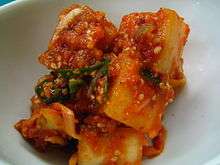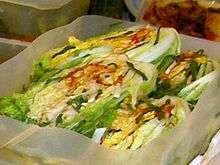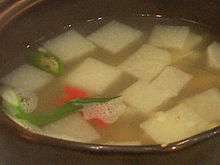List of kimchi varieties

This is a list of kimchi varieties, Korean traditional pickles in Korean cuisine.
Kimchi is a traditional Korean dish consisting of pickled vegetables, which is mainly served as a side dish with every meal, but also can be served as a main dish.[1] Kimchi is mainly recognized as a spicy fermented cabbage dish globally, but there are currently more than 200 variations, and continues to grow.[2] These variations of kimchi continues to grow, and the taste can vary depending on the region and season [3]
History
Kimchi has been a staple in Korean culture, but historical versions were not a spicy dish.[4] Theories of the origin of Kimchi varies including a belief that it appeared during the Shilla Dynasty, and became prevalent once Buddhism caught on throughout the nation and fostered a vegetarian lifestyle.[5] However, the addition of spicy peppers to this cultural dish did not appear until the arrival of Portuguese missionaries in the 1700s who brought chili peppers.[6] The pickling of vegetables was an ideal method, prior to refrigerators, that helped to preserve the lifespan of foods. In Korea, kimchi was made during the winter by fermenting vegetables, and burying it in the ground in traditional brown ceramic pots, and further allowed a bonding between women within the family.[7]
Varieties

- Baechu-kimchi or Yang baechu-kimchi, made with Napa cabbage or cabbage, is a spicy pickled cabbage dish and is the most popular of the kimchi varieties, which is made from whole, salted cabbage leaves,
- Kkakdugi-kimchi, or daikon-kimchi, is a spicy cubed radish dish, similar in spices to baechu-kimchi and the use of fermented shrimp emits a darker color and strong scent.
- Suk kkakdugi, cubed daikon kimchi after parboiled daikon
- Nabak-kimchi, also known as water kimchi, is less spicy and is a soupy side dish that consists of cabbage and radish.
- Oisobagi, is a cucumber kimchi, that can be stuffed with seafood and chili paste, and is a popular choice during the spring and summer seasons.
- Yeolmu-kimchi is also a popular choice during the spring and summer, and is made with young summer radishes, and does not necessarily have to be fermented.
- Bo-kimchi is best made fresh before a meal and are made with cabbage leaves wrapped around a blend of other inner ingredients such as seafood or fruit.
- Pa-kimchi is a hot and spicy dish made with medium sized green onions.
- Dongchimi is a light and non-spicy watery radish dish.
- Chonggak-kimchi is a spicy ponytail radish kimchi dish that is one of the most popular kimchi versions.
- Yongpyon gimjang kimchi (Yongbyon style kimchi)
- Gaji kimchi, pickled eggplant
- Gat kimchi, made with Indian mustard
- Baek kimchi (white kimchi), kimchi without chili pepper
- Bossam kimchi, wrapped kimchi
Mul kimchi (water kimchi)

See also
References
- ↑ Korean Tourism Organization. (2015). Kimchi.
- ↑ Logarta, M. T. (2013). In A Pickle. Business Traveller (Asia-Pacific Edition), 70-73.
- ↑ Kimchi. (2016). Funk & Wagnalls New World Encyclopedia, 1p. 1.
- ↑ Kimchi. (2016). Funk & Wagnalls New World Encyclopedia, 1p. 1.
- ↑ Logarta, M. T. (2013). In A Pickle. Business Traveller (Asia-Pacific Edition), 70-73.
- ↑ Logarta, M. T. (2013). In A Pickle. Business Traveller (Asia-Pacific Edition), 70-73.
- ↑ Logarta, M. T. (2013). In A Pickle. Business Traveller (Asia-Pacific Edition), 70-73.